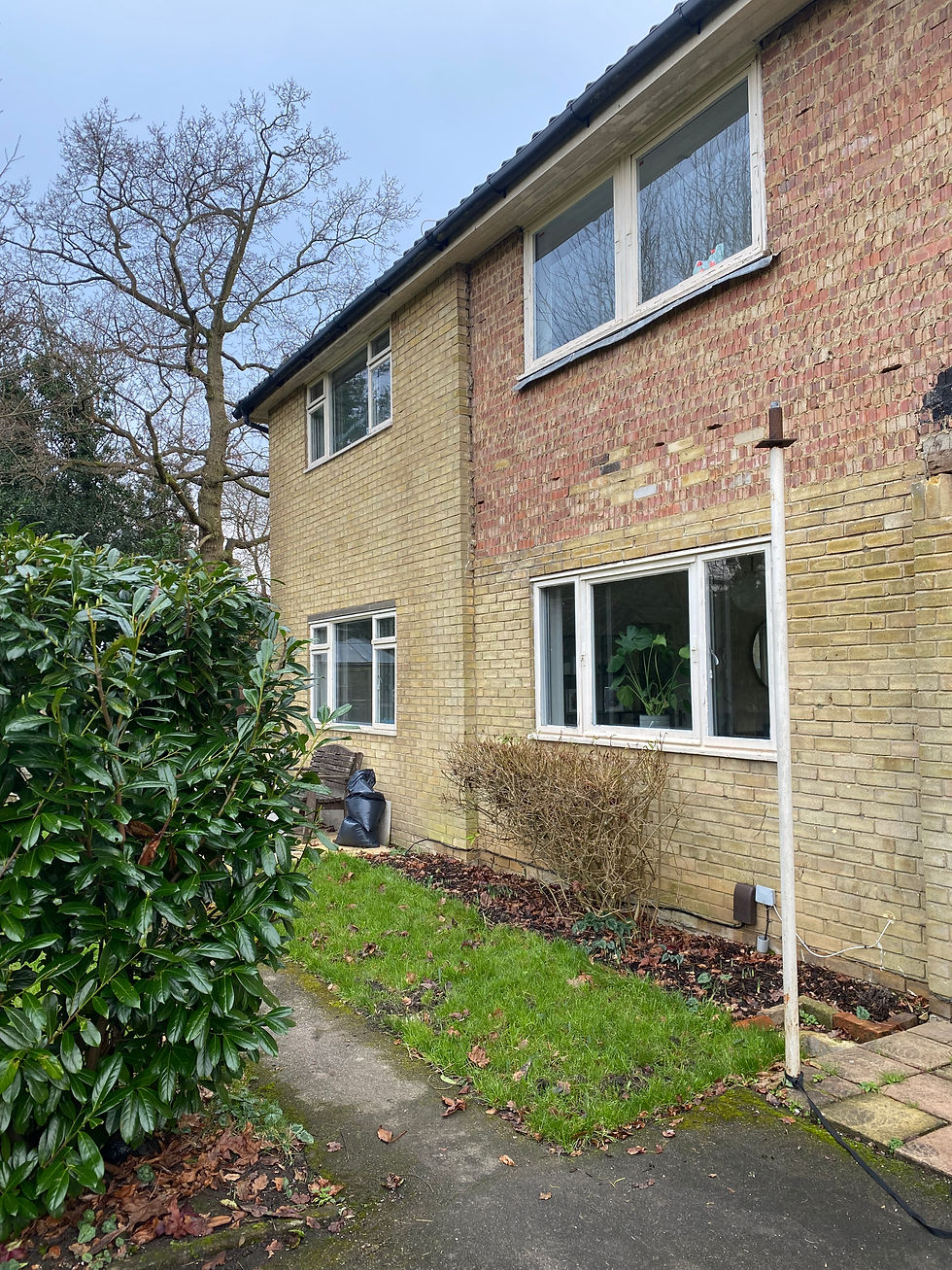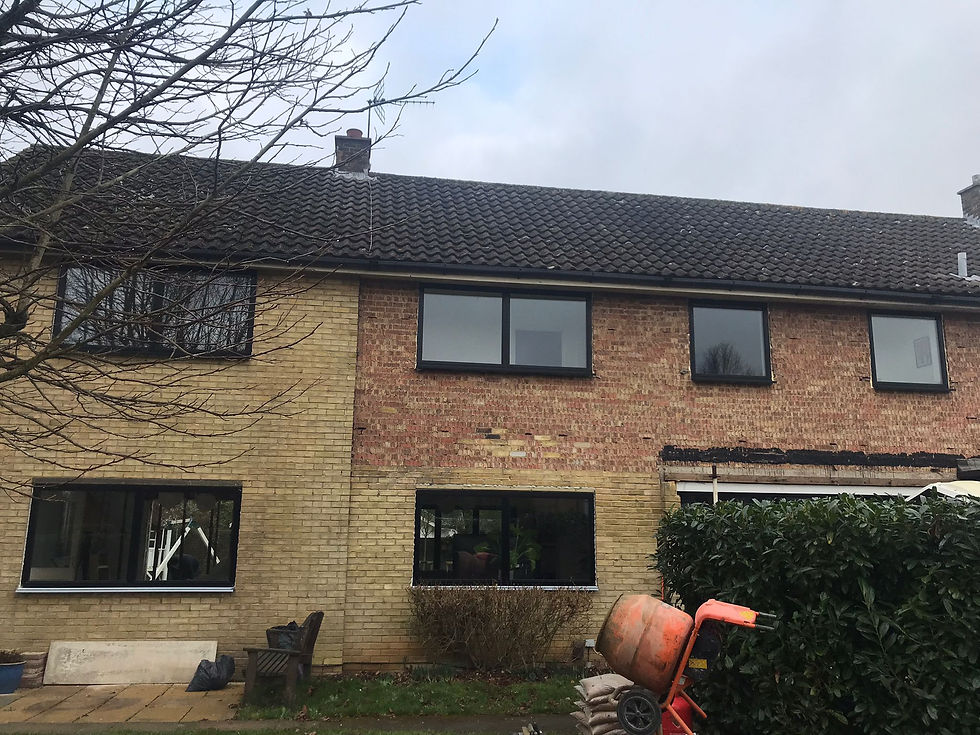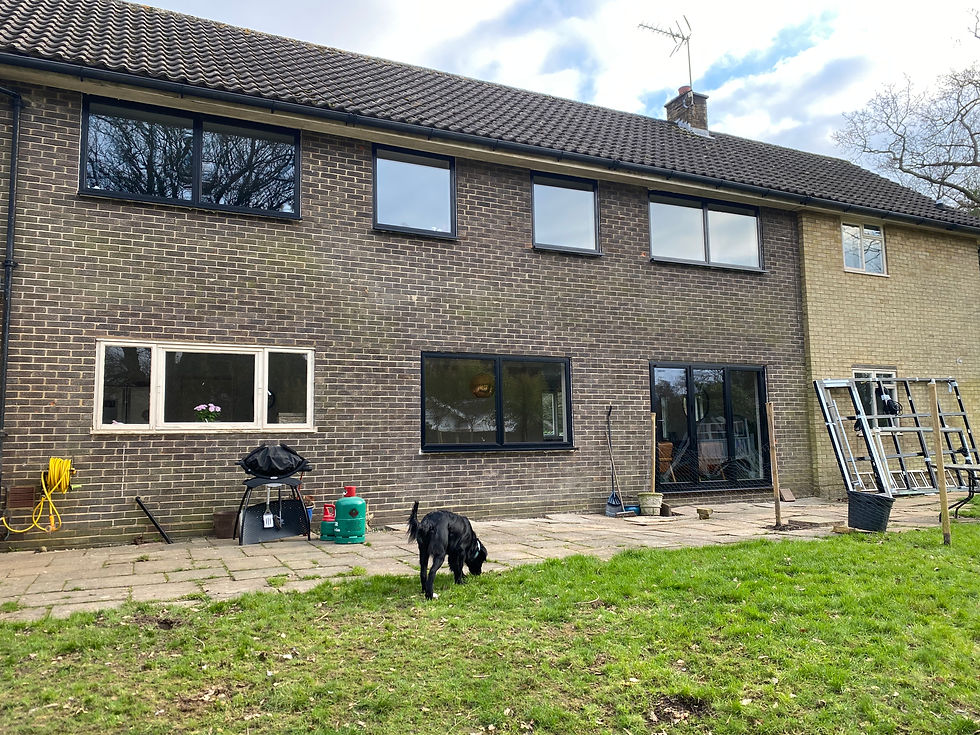Replacing windows in a House Renovation
- sarah burrows
- Apr 1
- 7 min read
In every house renovation I’ve done, I had to repace all the windows. as they were single-glazed! If you’re renovating, here are a few key questions to ask yourself:
✔ Are they single-glazed? If so, upgrading to double or triple glazing will improve insulation, reduce noise, and cut energy bills.
✔ Are they drafty or letting in moisture? If you feel cold spots or see condensation between panes, your windows aren’t performing efficiently.
✔ Do they open and close properly? Warped or sticking windows can be a sign of damage or poor installation.
✔ Do they suit your home’s style? Upgrading old or mismatched windows can completely transform a property’s look and value.
✔ Are they secure? Modern windows offer better locks and reinforced glass, improving home security.
💡 Tip: If the frames are in good condition but the glazing is failing, you may be able to reglaze instead of replacing the entire unit!
Choosing the Right Windows for Your Home Renovation
Windows play a huge role in both the aesthetic and functionality of your home. When deciding on the type of windows for your renovation, it’s important to consider not just energy efficiency and security but also how they complement the style of your property.
1. Respect the Character of Your Home
The style of your home should guide your choice of windows. If you have a period property, preserving or replacing traditional sash windows might be the best approach to maintain its charm. For a contemporary renovation, sleek steel-framed windows can create a bold statement.
2. Material Matters
• Timber Windows – Ideal for period homes and conservation areas, offering a classic, warm look.
• uPVC Windows – A cost-effective, low-maintenance option available in various styles and finishes.
• Aluminium or Steel Windows – Perfect for modern homes, adding a slim-profile, industrial feel while being durable and energy-efficient.
3. Think About Functionality & Performance
Beyond aesthetics, your windows need to be practical. Consider:
✔ Glazing Options – Double or triple glazing improves insulation and reduces noise.
✔ Ventilation Needs – Do you need larger openings for airflow? Tilt-and-turn windows are great for flexibility.
✔ Security Features – Modern locking mechanisms enhance safety.
4. Making a Statement
Windows aren’t just practical—they can be a design feature. Floor-to-ceiling glass, steel-framed partitions, or arched windows can completely transform a space. Think about how your windows contribute to the overall vision of your renovation.
5. Energy Efficiency & Sustainability
Upgrading windows can improve energy efficiency, keeping your home warmer in winter and cooler in summer. Look for high-performance glazing and sustainable materials to reduce your carbon footprint.
Final Thoughts for Choosing the Right Windows for Your Home Renovation
Whether you’re restoring sash windows, replacing outdated uPVC, or opting for striking steel-framed designs, your choice of windows can elevate your entire renovation. Take time to research and choose wisely—it’s an investment that enhances both the beauty and efficiency of your home.
How to Budget for Windows in a House Renovation
Windows are a crucial part of any home renovation—impacting energy efficiency, security, and overall aesthetic. But with so many styles, materials, and glazing options available, budgeting for new windows can be overwhelming. Here’s how to plan your costs effectively and ensure you make the right investment.
1. Assess Your Needs
Before setting a budget, determine why you’re replacing your windows. Are they inefficient and costly to heat your home? Do they need upgrading for security or aesthetics? Understanding your priorities will help you allocate your budget wisely.
2. Factor in the Cost of Different Window Types
Window prices vary depending on materials, style, and glazing. Here’s a general cost breakdown per window:
✔ uPVC Windows – £300–£1,500 (affordable, low maintenance)
✔ Timber Windows – £800–£3,000 (great for period homes, higher maintenance)
✔ Aluminium or Steel Windows – £1,200–£4,000 (sleek, modern, durable)
✔ Bespoke Windows – £2,000+ (custom designs, heritage requirements, or large statement windows)
3. Consider Installation Costs
Installation costs can range from £250 to £1,000 per window, depending on accessibility, labour, and complexity. If you’re in a listed building or conservation area, additional planning and specialist installation may be required, adding to the cost.
4. Budget for Glazing Options
✔ Double Glazing – Standard for most homes, offering insulation and noise reduction.
✔ Triple Glazing – More energy-efficient but adds 20–40% to the cost.
✔ Heritage Glass – Slim-profile double glazing designed for period properties, often more expensive.
✔ Acoustic Glass – Ideal for homes in busy areas, reducing noise but increasing costs.
5. Energy Efficiency & Long-Term Savings
Investing in high-performance glazing and frames may cost more upfront but can save money in heating bills over time. Look for:
✔ Low U-Value Windows – Indicate better insulation.
✔ Solar Control Glass – Reduces overheating in sunny areas.
✔ Sustainable Materials – FSC-certified timber or recycled aluminium options.
6. Hidden Costs to Watch Out For
✔ Planning Permission & Building Regulations – If your home is listed or in a conservation area.
✔ Scaffolding – Needed for upper-floor installations.
✔ Repairs to Surrounding Walls – If old frames cause damage upon removal.
✔ Blinds & Curtains – New windows may require new window treatments.
7. Get Multiple Quotes & Plan for Contingency
Always get at least three quotes from reputable suppliers and installers. Set aside a contingency budget of 10–20% for unexpected costs.
Final Thoughts How to Budget for Windows in a House Renovation
Windows are a significant investment in any renovation. By understanding costs, material choices, and installation requirements, you can create a realistic budget that balances quality, aesthetics, and energy efficiency.
When Should You Replace Windows in a House Renovation?
Windows play a crucial role in any home renovation, affecting insulation, aesthetics, and overall comfort. But when is the right time to replace them in your project timeline? Replacing windows at the wrong stage can lead to unnecessary costs, rework, and damage to finished areas. Here’s how to plan window installation effectively.
1. Before Any Interior Finishes
If you’re replacing or upgrading windows, it should happen before plastering, painting, flooring, and other finishing touches inside your home. Removing old windows can create dust, debris, and potential damage to surrounding areas, so it’s best to complete this messy work early in the process.
✔ Ideal Time: After structural work but before internal finishes.
2. After Major Structural Changes
If your renovation involves extensions, wall alterations, or changing window sizes, wait until these structural modifications are complete. New windows should be fitted after any major building work to ensure they are installed in the correct positions with accurate measurements.
✔ Ideal Time: Once structural work is done, but before insulation and plastering.
3. Before Insulation & Plastering
Energy-efficient windows contribute significantly to home insulation. Installing them before plastering and insulation work ensures a proper fit and minimizes drafts. It also prevents damage to new interior walls and finishes.
✔ Ideal Time: Before interior walls are finished to prevent rework.
4. Before Exterior Finishes (If Changing Window Style)
If you’re upgrading from uPVC to timber, switching to steel-framed windows, or adding a statement feature, plan this before finalizing your exterior finishes like cladding, rendering, or brickwork repairs.
✔ Ideal Time: Before external cladding or rendering to ensure seamless integration.
5. Staged Approach for Budgeting
If your renovation budget is tight, you can replace windows in stages:
1️⃣ Prioritize the worst windows first – Replace single-glazed or damaged windows immediately.
2️⃣ Upgrade room by room – If you’re renovating in phases, install new windows in completed areas first.
3️⃣ Consider phased installation – Some suppliers offer flexible fitting schedules to help spread costs.
✔ Ideal Time: Based on budget and urgency, but best before decorating.
6. If Keeping Existing Windows: Repair First!
If you’re keeping original timber sash or steel-framed windows, restore them before interior work starts to avoid dust and disruption later. Reglazing, draught-proofing, or repainting should be done before finishing walls and floors.
✔ Ideal Time: Before interior finishes to avoid dust and damage.

Sarah Burrows Interiors: Full House Renovation in Tunbridge Wells


Final Thoughts When Should You Replace Windows in a House Renovation?
The best time to install new windows in a renovation is after structural work but before interior finishes. This ensures a seamless fit, avoids costly rework, and helps maximize energy efficiency.
💡 Tip: Always check if you need planning permission, especially in conservation areas or listed buildings!
How an Interior Designer Can Help with Window Selection & Installation in a Renovation
Windows are one of the most important design elements in a home, impacting light, insulation, and the overall aesthetic. As an interior designer, I help my clients make informed decisions about window replacements and upgrades to enhance both functionality and beauty. Here’s how I can assist:
1. Window Style & Aesthetic Guidance
Your windows should complement the architecture and interior style of your home. I help clients:
✔ Choose between sash, casement, steel-framed, or contemporary floor-to-ceiling glazing.
✔ Select materials that suit their design vision—timber, aluminum, or uPVC.
✔ Ensure windows integrate seamlessly with the overall design scheme.
2. Planning & Budgeting Support
Window replacement can be a significant investment, and I provide expert guidance on:
✔ Prioritizing which windows to replace first if working within a phased budget.
✔ Selecting high-quality, energy-efficient options that provide long-term savings.
✔ Sourcing reputable window suppliers and installers within your budget.
3. Space Planning & Natural Light Optimization
A well-designed home maximizes natural light and functionality. I assist by:
✔ Positioning windows for optimal daylight, privacy, and views.
✔ Advising on glazing options to enhance brightness and energy efficiency.
✔ Recommending window treatments that complement the space without blocking light.
4. Coordination with Contractors & Installers
Managing window installation requires coordination with multiple trades. I work with:
✔ Architects and builders to ensure correct placement and sizing.
✔ Window suppliers to select the right specifications.
✔ Installers to fit windows at the right stage of the renovation process.
5. Regulations & Planning Considerations
If your home is in a conservation area or a listed building, I help navigate:
✔ Planning permission requirements for window replacements.
✔ Compliance with building regulations for energy efficiency.
✔ Ensuring historical features are preserved where necessary.
6. Window Treatments & Finishing Touches
Once your windows are installed, I guide you in:
✔ Choosing the perfect curtains, blinds, or shutters for both style and function.
✔ Layering textures and fabrics to enhance the overall aesthetic.
✔ Ensuring window treatments provide privacy while maintaining light flow.



Transform Your Home with Thoughtful Window Design
Windows are more than just functional elements—they shape the entire feel of a space. If you’re renovating and unsure how to integrate new windows into your design, I’d love to help. Let’s create a home that’s light-filled, energy-efficient, and beautifully designed!
📩 Get in touch to discuss your renovation project!
Sarah Burrows Interiors



Comments